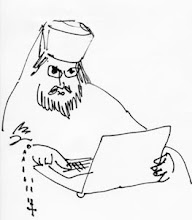
- There is one God, the Father, one Lord Jesus Christ, and one Holy Spirit. The Father is the source of the divinity: it is from the Father that His Son is eternally (i.e., non-temporally) begotten and that the Holy Spirit eternally (i.e., non-temporally) proceeds. We are led by the Holy Spirit to know the Son, Who shows us the Father
- Father, Son, and Holy Spirit are one in unnameable essence but are hypostatically distinguishable and nameable: the Father is unbegotten, the Son is the only-begotten of the Father, and the Holy Spirit proceeds from the Father. Essence (ousia) refers to that which is common (which in the divinity can be spoken of only apophatically) and hypostasis refers to particularizing characteristics.
- The unity of Father, Son, and Holy Spirit may be expressed in terms of communion, mutual indwelling, and common activity, will, or energy.
It follows that:
- There is one God because there is one Father.
- The source of unity in the Trinity is the Father, not the shared essence.
- This unity is expressed in the co-operation of the Son and the Holy Spirit with the Father, not in the shared essence (consubstantiality).
Remember:
- Be precise with your language. It is not correct to state that “God is Trinity” or that “God is one in three and three in one” or to refer to the “Triune God.” The authors of the New Testament, the Fathers, and the compilers of the liturgical books did not use these expressions, and neither should you. One may, however, speak of the “Triune Godhead” or “Triune Divinity.”
- The “monarchy” of the Father means that He is the single source of the Son and Holy Spirit, not that he is the “king” of the Trinity.
- Although there is one God and Father, it does not follow that the Son and the Holy Spirit are any less divine. Father, Son, and Holy Spirit are equally divine; they are divine with the same, full divinity of the Father. Jesus Christ is the Son of God, that is. He is everything that the Father is, without being the Father. On that basis, we may say that Christ Himself is God and, consequently, confess that the Virgin Mary is truly Theotokos (Mother of God), who is the mother not of the divinity, but of God the Word made flesh. Likewise, because Christ’s incarnation deified the flesh and sanctified matter, we may venerate material images (e.g., icons, cross, the Gospel, relics).
- Our starting point in thinking about the Holy Trinity should not be a metaphysical puzzle about one in three and three in one. Rather, our starting point should always be Jesus Christ preached by the Apostles according to the Scriptures. The theological writings of the Fathers give a grammar by which the Scriptural data may be rightly understood; their terminology serves primarily as an exegetical guide to Scripture. However, our theological language does not describe the very essence God. Moreover, the divine essence is unknowable, but is revealed and communicated to us in His divine energies, by which we are deified. While one may distinguish between essence and energy, these are not two “parts” of God.









1 comment:
Great article as for me. It would be great to read a bit more about that matter.
BTW check the design I've made myself Young escorts
Post a Comment